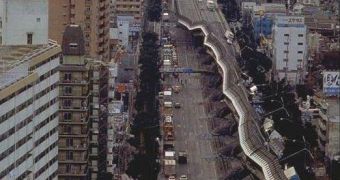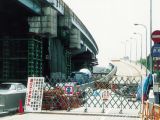Earthquakes are some of the nature's most destructive forces and the main problem about them is that we can't really predict when and where they are going to occur next. Of course, there are fault lines and areas where tectonic activity has been recorded for hundreds of years, but we can't say for sure: tomorrow we will have an earthquake.
Another big problem with these sudden movements of the tectonic plates is the fact that by themselves, they don't quite result in many casualties, like for instance a volcanic eruption, a tornado or a tsunami. In fact we are the responsible ones for the victims.
How? Most of them are killed or injured not because of the vibrations but by their terrible effects on our technology, by rupturing gas and oil pipes and setting them ablaze, bringing down suspended highways and railways, but mostly by collapsing buildings.
But since we can't all be living in the countryside, with none of the creature comforts we've become so used to, what can we do to know when an earthquake is coming?
Earthquake prediction is more or less like hunting for the perfect storm; we know it's gonna happen some day, we know approximately where, but we can only detect it just before or while it is actually happening.
Not even seismologists, the scientists who study this phenomenon, can say that there's one reliable and reproducible prediction technique. The most advanced one they have is the seismic hazard assessment program, which estimates the probabilities that a given earthquake or suite of earthquakes will occur.
Japan, for instance, has the most advanced technology in the world for predicting these events, but the country could not escape the latest one, which damaged the world's biggest nuclear plant, killed 10 people and injured more than 1,000 this week.
They have the most reliable early warning system, but this can only alert people of the incoming earthquake with an average of 6.6 seconds in advance, according to Japan's Meteorological Agency. This system detects the P waves produced by earth movement in the early stage and uses them to predict the magnitude and timing of the worst shaking brought on by the "S" wave.
Warnings are then sent through TV, radio, cell phones and even home devices and with a bit of luck, people have 20 seconds at most to get to safety. Unfortunately, in real life, time doesn't pass in slow motion like when the main character in the movie has 10 seconds to run from a bomb about to detonate and in fact the sequence takes 5 minutes.
The 10 seconds in real life are just enough to get under a desk or in the doorstep or near the structural strong points of a building, like pillars and arches. Still, the Japanese are real role models in these situations, since they are well trained to deal with this type of situations. If we combine their training and reflexes and the latest building technology, we find out why there are minimal casualties after a strong earthquake.
Just imagine what an earthquake with the magnitude of 6.6 on the Richter scale would do to buildings where you live and then compare that with the fact that only 10 people were killed in Japan, most of them elderly who could not get to safety in time.
How many would that have killed in a densely populated but technologically inferior area, like the suburbs of Mexico City or Sao Paolo, or even the old European cities, like Paris, Rome or London, with many centuries-old buildings?
Let's face it, the casualties would have been much higher and the infrastructure would take years to recover. But Japan has made a "national commitment" to preparing for earthquakes, including necessary funding, training the citizens, regular emergency drills and the largest network of seismic monitors in the world, with roughly 1,000 that can sound earthquake alerts.
The bottom line is, maybe we will never be able to accurately predict earthquakes, so in this case we might have to learn from the best and start doing what they do: learn to survive. They proved it's possible after the two nuclear attacks, after each earthquake, after each tsunami, so why couldn't we do it?

 14 DAY TRIAL //
14 DAY TRIAL // 
